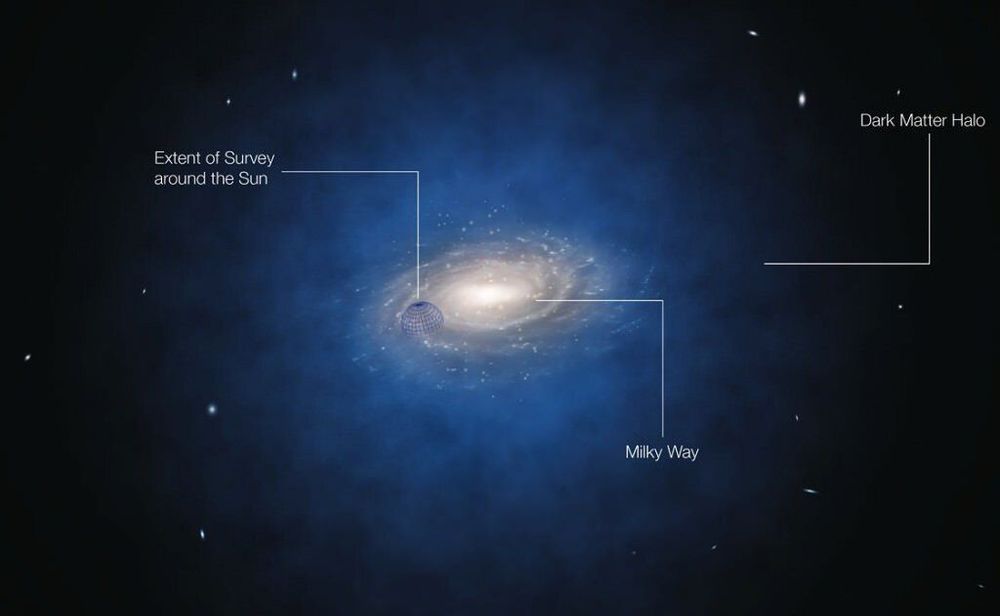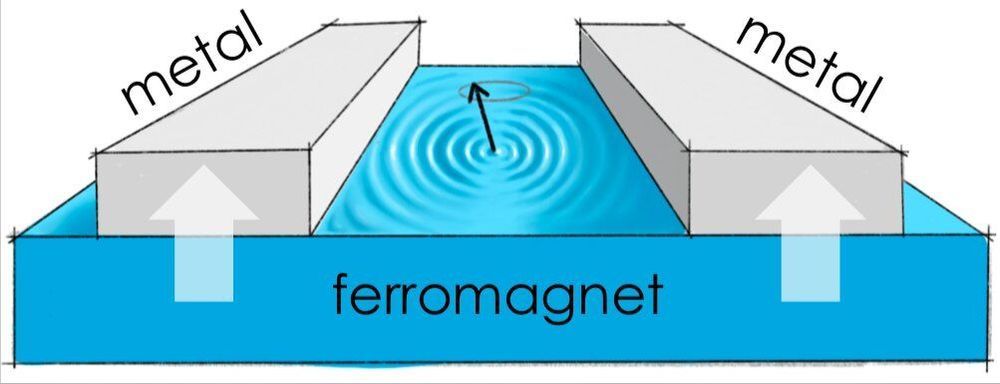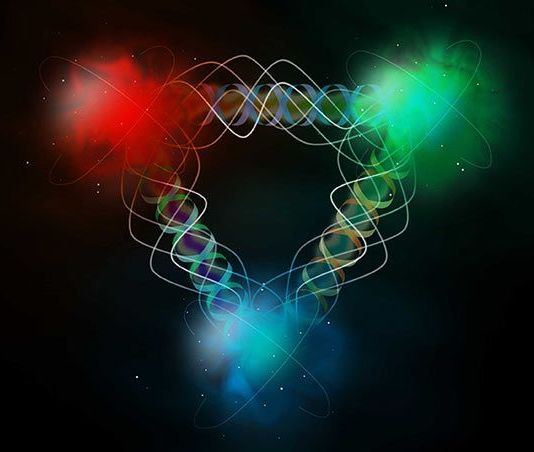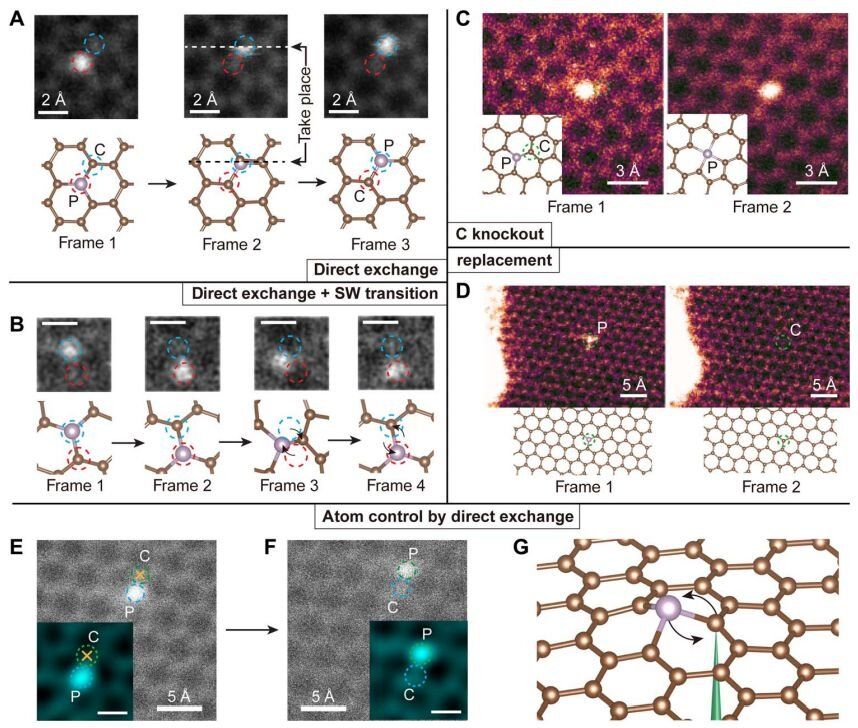Archive for the ‘particle physics’ category: Page 465
May 21, 2019
A method to determine magnon coherence in solid-state devices
Posted by Quinn Sena in categories: particle physics, quantum physics
A team of researchers at Utrecht University, the Norwegian University of Science and Technology and the University of Konstanz has recently proposed a new method to determine magnon coherence in solid-state devices. Their study, outlined in a paper published in Physical Review Letters, shows that cross-correlations of pure spin currents injected by a ferromagnet into two metal leads normalized by their dc value replicate the behavior of the second-order optical coherence function, referred to as g, when magnons are driven far from equilibrium.
“Consider a big room full of people having a party,” Akash Kamra, one of the researchers who carried out the study, told Phys.org. “These people can either behave as in a night club, bumping into each other in an uncoordinated way and with chaotic movements, or the party people might be directed by a common host, such as at a wedding party. Such a ‘condensed’ crowd of people moves swiftly without bumping into each other.”
Kamra draws an analogy between the party situations he described and magnons, quantum particles that correspond to a specific decrease in magnetic strength, traveling as a unit through a magnetic substance. In his analogy, an uncoordinated “party” would occur if magnons are in a “thermal” state, while a coordinated one if they are in a “coherent” or “condensed” state. The coordinated movement of guests in the second type of party, on the other hand, would correspond to a superfluid flow, which is a manifestation of a remarkable state of matter: the condensate.
Continue reading “A method to determine magnon coherence in solid-state devices” »
May 20, 2019
A universal description of non-equilibrium colloid phase separation
Posted by Quinn Sena in category: particle physics
Liquids, with their flowing dynamics, are often far from equilibrium. This makes it particularly hard to model processes in soft matter or living tissue, which contain liquids. New research from the University of Tokyo’s Institute of Industrial Science (IIS) offers an elegant approach to modeling the self-organization of out-of-equilibrium systems.
Such systems naturally try to self-organize into more stable states. Colloidal suspensions—homogeneous suspensions of undissolved particles in a liquid, which are widespread in nature—tend to separate out over time if colloids strongly attract with each other. A major difficulty in modeling this process is the complex dynamical interaction between colloids and liquid. The two components have very different dynamics that are hard to unite in a single model.
The IIS study, published in Nature Computational Materials, resolves this through an approach termed fluid particle dynamics (FPD). Instead of being treated as solids, the suspended colloid particles are simulated as undeformable highly viscous liquid droplets. This effectively makes the colloidal suspension a binary liquid mixture, and removes the need for complicated treatment of a solid-liquid boundary condition.
Continue reading “A universal description of non-equilibrium colloid phase separation” »
May 20, 2019
Is dark matter made of axions? Black holes may reveal the answer
Posted by Genevieve Klien in categories: cosmology, evolution, particle physics

What is dark matter made of? It’s one of the most perplexing questions of modern astronomy. We know that dark matter is out there, since we can see its obvious gravitational influence on everything from galaxies to the evolution of the entire universe, but we don’t know what it is. Our best guess is that it’s some sort of weird new particle that doesn’t like to talk to normal matter very often (otherwise, we would have seen it by now). One possibility is that it’s an exotic hypothetical kind of particle known as an axion, and a team of astronomers are using none other than black holes to try to get a glimpse into this strange new cosmic critter.
Axion Agenda
Continue reading “Is dark matter made of axions? Black holes may reveal the answer” »
May 18, 2019
How Feynman Diagrams Revolutionized Physics
Posted by Quinn Sena in category: particle physics
In the late 1940s, Richard Feynman invented a visual tool for simplifying particle calculations that forever changed theoretical physics.
May 17, 2019
Exploring the scientific potential of the ATLAS Experiment at the High-Luminosity LHC
Posted by Quinn Sena in categories: life extension, particle physics
The High-Luminosity upgrade of the Large Hadron Collider (HL-LHC) is scheduled to begin colliding protons in 2026. This major improvement to CERN’s flagship accelerator will increase the total number of collisions in the ATLAS experiment by a factor of 10. To cope with this increase, ATLAS is preparing a complex series of upgrades including the installation of new detectors using state-of-the-art technology, the replacement of aging electronics, and the upgrade of its trigger and data acquisition system.
What discovery opportunities will be in reach for ATLAS with the HL-LHC upgrade? How precisely will physicists be able to measure properties of the Higgs boson? How deeply will they be able to probe Standard Model processes for signs of new physics? The ATLAS Collaboration has carried out and released dozens of studies to answer these questions—the results of which have been valuable input to discussions held this week at the Symposium on the European Strategy for Particle Physics, in Granada, Spain.
“Studying the discovery potential of the HL-LHC was a fascinating task associated with the ATLAS upgrades,” says Simone Pagan Griso, ATLAS Upgrade Physics Group co-convener. “The results are informative not only to the ATLAS Collaboration but to the entire global particle-physics community, as they reappraise the opportunities and challenges that lie ahead of us.” Indeed, these studies set important benchmarks for forthcoming generations of particle physics experiments.
May 17, 2019
Ultra-clean fabrication platform produces nearly ideal 2-D transistors
Posted by Quinn Sena in categories: business, computing, engineering, particle physics

Semiconductors, which are the basic building blocks of transistors, microprocessors, lasers, and LEDs, have driven advances in computing, memory, communications, and lighting technologies since the mid-20th century. Recently discovered two-dimensional materials, which feature many superlative properties, have the potential to advance these technologies, but creating 2-D devices with both good electrical contacts and stable performance has proved challenging.
Researchers at Columbia Engineering report that they have demonstrated a nearly ideal transistor made from a two-dimensional (2-D) material stack—with only a two-atom-thick semiconducting layer—by developing a completely clean and damage-free fabrication process. Their method shows vastly improved performance compared to 2-D semiconductors fabricated with a conventional process, and could provide a scalable platform for creating ultra-clean devices in the future. The study was published today in Nature Electronics.
Continue reading “Ultra-clean fabrication platform produces nearly ideal 2-D transistors” »
May 17, 2019
An experiment hints at quantum entanglement inside protons
Posted by Quinn Sena in categories: particle physics, quantum physics
Protons are complicated. The subatomic particles are themselves composed of smaller particles called quarks and gluons. Now, data from the Large Hadron Collider hint that protons’ constituents don’t behave independently. Instead, they are tethered by quantum links known as entanglement, three physicists report in a paper published April 26 at arXiv.org.
Quantum entanglement has previously been probed on scales much larger than a proton. In experiments, entangled particles seem to instantaneously influence one another, sometimes even when separated by distances as large as thousands of kilometers (SN: 8/5/17, p. 14). Although scientists suspected that entanglement occurs within a proton, signs of that phenomenon hadn’t been experimentally demonstrated inside the particle, which is about a trillionth of a millimeter across.
“The idea is, this is a quantum mechanical particle which, if you look inside it, … it’s itself entangled,” says theoretical physicist Piet Mulders of Vrije Universiteit Amsterdam, who was not involved with the research.
Continue reading “An experiment hints at quantum entanglement inside protons” »
May 17, 2019
NIST team demonstrates heart of next-generation chip-scale atomic clock
Posted by Quinn Sena in categories: computing, particle physics, satellites
Physicists at the National Institute of Standards and Technology (NIST) and partners have demonstrated an experimental, next-generation atomic clock—ticking at high “optical” frequencies—that is much smaller than usual, made of just three small chips plus supporting electronics and optics.
Described in Optica, the chip-scale clock is based on the vibrations, or “ticks,” of rubidium atoms confined in a tiny glass container, called a vapor cell, on a chip. Two frequency combs on chips act like gears to link the atoms’ high-frequency optical ticks to a lower, widely used microwave frequency that can be used in applications.
The chip-based heart of the new clock requires very little power (just 275 milliwatts) and, with additional technology advances, could potentially be made small enough to be handheld. Chip-scale optical clocks like this could eventually replace traditional oscillators in applications such as navigation systems and telecommunications networks and serve as backup clocks on satellites.
Continue reading “NIST team demonstrates heart of next-generation chip-scale atomic clock” »
May 17, 2019
Manipulating atoms one at a time with an electron beam
Posted by Quinn Sena in categories: computing, engineering, particle physics, quantum physics
The ultimate degree of control for engineering would be the ability to create and manipulate materials at the most basic level, fabricating devices atom by atom with precise control.
Now, scientists at MIT, the University of Vienna, and several other institutions have taken a step in that direction, developing a method that can reposition atoms with a highly focused electron beam and control their exact location and bonding orientation. The finding could ultimately lead to new ways of making quantum computing devices or sensors, and usher in a new age of “atomic engineering,” they say.
The advance is described today in the journal Science Advances, in a paper by MIT professor of nuclear science and engineering Ju Li, graduate student Cong Su, Professor Toma Susi of the University of Vienna, and 13 others at MIT, the University of Vienna, Oak Ridge National Laboratory, and in China, Ecuador, and Denmark.
Continue reading “Manipulating atoms one at a time with an electron beam” »
















